HUW TURBERVILL: A throng of big, aggressive Australian quick bowlers were either 'chucking' the ball at them, or taking advantage of the no-ball Law at the time to drag the toes of their back feet over the return crease. Or both…

"He was huge, and he threw it at you. There were no crash helmets back then. All you could do was stand there and fend it off."
England were finding the tour to Australia in 1958/59 a bit of a drag. A throng of big, aggressive Australian quick bowlers were either 'chucking' the ball at them, or taking advantage of the no-ball Law at the time to drag the toes of their back feet over the return crease so they could deliver the ball from closer to the batsmen. Or both.
Tom Graveney’s quote above refers to a New South Welshman called Gordon Rorke, but it was actually a Victorian left-armer, Ian Meckiff, who gave England the most problems. Not only did he drag, but he had a permanent bend in his bowling arm. "We faced him in the state game at Melbourne, and we all had a little chat about him," Graveney said. "We decided not to pursue a complaint..."
Trevor Bailey also recalls facing Meckiff. "He managed to break the batting crease with his back foot which intimates that he got pretty close to you when you were facing," Bailey said. "He dragged, right through the bowling crease. It was fairly obvious." Were the England team angry, I asked him? "Yes!" On the tour, Bailey privately described Meckiff as "the worst bowler ever to represent Australia".
Frank Tyson also remembers when Meckiff first came on to the tourists’ radar. "The episode caused a lot of controversy," he said. "The English papers wanted to make a fuss about it, but we decided it was not 'politic'; it never looks good to squeal when you are losing. We knew he was more than just an orthodox bowler, but we said nothing."
Manager Freddie Brown was keen to make an official complaint to the Australian Board of Control; captain Peter May less so. Instead, they talked unofficially to Donald Bradman, Australia’s chairman of selectors, who said: "And what of the action of the England bowlers Tony Lock and Peter Loader?" He told the tourists to "first of all put your own house in order".
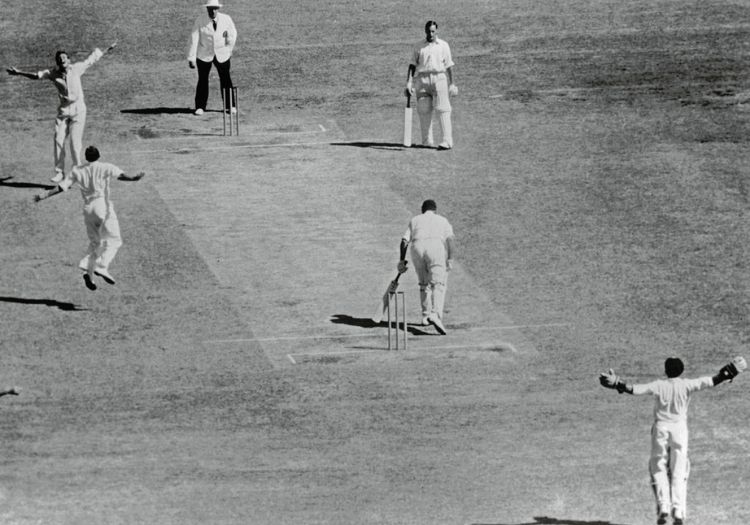
Ian Meckiff (left, facing) celebrates the wicket of Colin Cowdrey in Melbourne
Under the modern Law – introduced to counteract dragging – a no-ball is signalled if a bowler has no part of his front foot, either grounded or raised, behind the bowling crease, and if his back foot is not entirely inside the return crease. The Law when this series was played required only that one foot be behind.
Fast bowlers that winter, most notably Meckiff and Rorke, dragged so much that when they released the ball they were only 18 yards away from the batsman. Rorke was 6ft 5in and known as the Blond Giant. Facing him wasn’t much fun.
Ray Lindwall, who returned triumphantly in the fourth Test, was also a problem. He may proudly have boasted that he was 'the last of the straight-arm bowlers', but he was also a dragger.
"We had already met a few 'pingers' on the trip ... South Australia’s Alan Hitchcox and Peter Trethewey," Graveney said. "It was tough playing against throwers. Rorke had the longest drag you have ever seen. His front foot went six feet beyond the bowling crease."
May said later: "Englishmen who fell to Meckiff’s speed and lively lift were hardly happy at being victims of deliveries that began with a bent arm and finished with a pronounced wrist-whip." And yet not one no-ball was called for throwing or 'jerking' on the entire tour.
To say that the finger of suspicion, when it came to throwing and dragging, was only pointed at Australians would be unfair, however.
Loader was suspected of 'chucking' his bouncers, and Tyson wrote about him: "His inexplicable wide range of pace has from time to time, raised the suspicion of a 'kink' in his action."
Lock’s bent-arm action was a legacy of years of practising indoors under low ceilings. Indeed, he saw footage of himself bowling in the series in New Zealand later that winter and decided to remodel his action before he too fell foul of the authorities. Fred Trueman was also accused of dragging this time, just as Tyson had been four winters earlier.
Meckiff had been effective at Brisbane as Australia won the opening Test, taking 3 for 33 and 2 for 30, but he stepped up a level in the second Test at Melbourne. He was approaching his 24th birthday, and this was his sixth Test, and the first on his home ground. In the first innings, cheered on by 70,000, he bowled May for 113 with a swinging ball that he rated the best that he delivered in his career. It had been a sublime innings by May, replete with classical off-driving, and was the first century by an England captain in Australia since Archie McLaren’s 116 at Sydney in 1901/02.
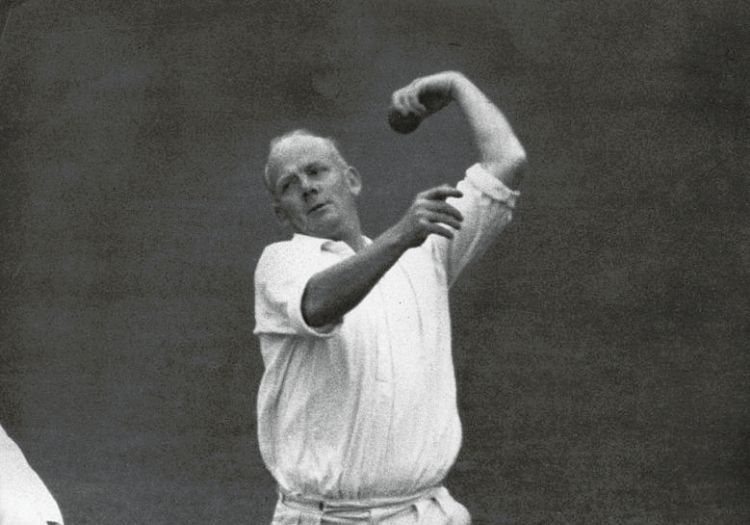
Tony Lock
Alan Davidson had taken the wickets of Peter Richardson, Watson and Graveney with the first, fourth and fifth balls of his second over, and after May’s removal, England collapsed, losing six wickets for 49 to reach 259.
Neil Harvey’s brilliant 167 helped Australia to a first-innings lead of 49, despite Brian Statham taking 7 for 57.
It was now that Meckiff dominated the stage, destroying England in the second innings. He dismissed opener Richardson for 3, then removed Bailey, Graveney (who described the catch by Davidson as "absolutely unbelievable") and Colin Cowdrey in rapid succession. He also picked up May for the second time in the match, and brought the innings to a conclusion by bowling Loader. He finished with 6 for 38 as England were bundled out for 87, their lowest total for more than 50 years.
Meckiff and his fellow left-arm paceman Davidson took 18 of England’s 20 wickets in the match, and Australia went on to win by eight wickets.
Meckiff was not allowed to bask in his success, however. Former England slow left-armer Johnny Wardle accused him of "throwing England out" in that evening edition’s of the Melbourne Herald. Alf Gover said not one of the home side’s deliveries had been legal. Jim Laker compared Meckiff and Burke to dart-throwers, while Trueman said: "Meckiff’s action was totally illegal… he should never have been allowed to play".
Some of the Australians did not take kindly to these attacks on their match-winner. Robert Coleman, historian of the Victorian Cricket Association, put the anger down to 'Fleet Street bleating', while captain Richie Benaud said he was "completely satisfied that Meckiff’s delivery was fair and legitimate".
Meckiff wrote in his autobiography, entitled Thrown Out, that the saga took its toll on his family. He denied throwing, but admitted he may have been open to suspicion when he approached the 20-over mark in a day.
The bowling Law regarding throwing and jerky actions was finally changed by the Imperial Cricket Conference in 1960, but for England in 1958/59, it was too late.
Even though they managed a draw in the third Test at Sydney, they were beaten at Adelaide and again at the SCG, losing the series 4-0. Meckiff taking 17 wickets at 17.17.
There can be no doubt that the bowling controversies knocked England’s confidence. They had been favourites to win, especially after their triumph in 1954/55, and their successful defence of the Ashes in 1956.
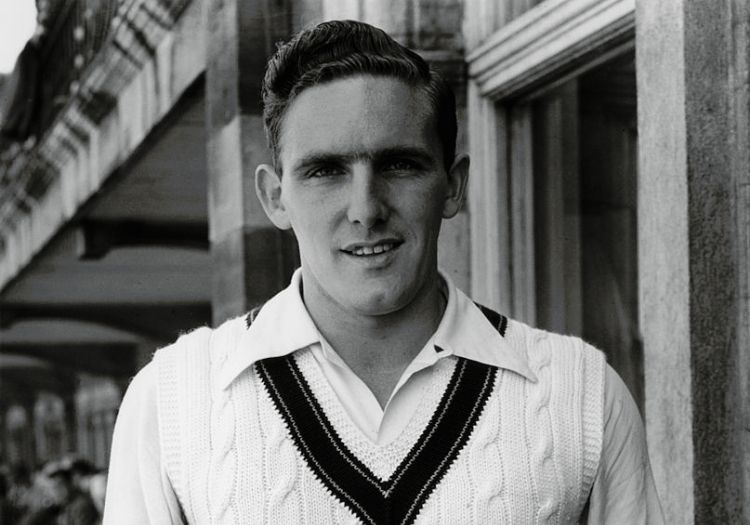
Alan Davidson
The party travelled to Australia on the SS Iberia. Qantas had introduced flights between Australia and London earlier in the year, but luxury liner was still MCC’s preferred option.
The tourists discovered an Australia still at ease with the 'Motherland'. Long-standing premier Robert Menzies was described as ‘British to his bootstraps’, while 200,000 had greeted the Queen Mother when she visited in February 1954.
There were hints that the atmosphere was starting to change, though. At the start of the 1950s there were 170,000 migrants in Australia, but by the end of the decade this number had reached one million. The majority of these newcomers were still from Britain, but a growing number were also from Greece and Italy.
Although the White Australia Policy was still in place until 1974, the campaign to recognise the rights of Australia’s indigenous population was just starting to gather momentum. And American culture was beginning to assert itself, thanks to the arrival of television.
It was still a country familiar to May, however, who was arriving for his second tour to Australia. He had enjoyed great success as captain, winning home series against South Africa (1955), Australia (1956), West Indies (1957) and New Zealand (1958), and drawing in South Africa in 1956/57. He also had a battery of formidable pace bowlers at his disposal, including Australia’s nemesis Tyson. However, he was not the bowler that he was four years earlier. He had lost a lot of his pace, sat out the first three Tests, and made minimal impression in the final two. As a result, Australia were able to reassert their supremacy.
There were other factors in the defeat. Even though May (405 runs at an average of 40.50) and Cowdrey (391 at 43.44) had fine series, England failed to score more than 300 in a Test innings. They suffered a number of injuries, their fielding was inferior to the hosts, and they also felt they were the victim of some poor umpiring. Benaud’s leadership in the series was more dynamic, and he backed his pacemen by setting intimidating fields.
Graveney admitted to me: "We were never a team. We had a lot of injuries and we were never in the hunt. It was a poor tour."
May took his fiancée, Virginia Gilligan, on the trip, and he did not spend enough time with his team; the affair attracted a great deal of newspaper criticism. "Peter was a great friend and a good captain, but there was no doubt the whole business was a distraction," said Graveney.
"Desmond Eager and Freddie Brown were joint managers and they showed poor leadership. Let’s just say Freddie was a better cricketer than a manager," said Graveney. "We also had a couple of very unlucky injuries... Willie Watson hurt his knee on the boat on the way out and Raman Subba Row fractured his wrist just before the first Test."
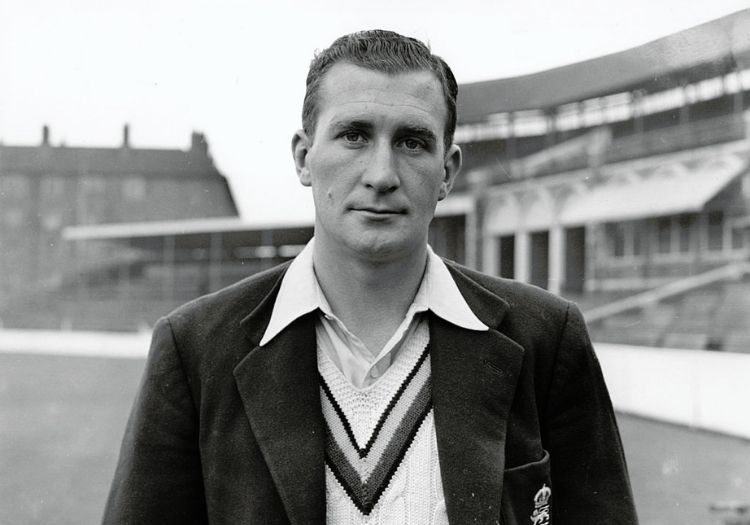
Jim Laker
The warm-up matches went well, however. The spin duo of Laker (off-breaks) and Tony Lock (slow left-arm), match-winners in the previous Ashes series, suggested that they could also play a decisive role Down Under. England were relieved that Laker, who had famously taken 19 wickets against Australia at Old Trafford in 1956, made the trip – he had indicated initially that he was unavailable, only to change his mind.
Graveney scored an unbeaten 177 against Western Australia, and May and Cowdrey also struck centuries against a Combined XI, with both matches at Perth drawn.
Laker’s 10-wicket match haul helped England defeat South Australia by nine wickets, then another late call-up, Statham, (who took 7 for 47 in the first innings) and Lock (6 for 74 in the second) blew Victoria away. Centuries in each innings by May defeated an Australian XI at Sydney. Things looked propitious for tourists.
England found Australia a different proposition in the first Test at The Gabba, though, despite an extraordinarily obdurate performance from Bailey. It was the first match to be televised in Australia, and was probably not the best advertisement for Test cricket for anyone who had never been to a live game.
May led England for the 26th match in succession, to overtake Australian Bill Woodfull’s Ashes record, and won the toss. That was as good as it got.
Davidson, Benaud and Meckiff took three wickets apiece as England managed only 134 in four and a half hours in the first innings, Bailey top-scoring with 27. He then took three wickets as England, without the injured Trueman, fought back, restricting Australia to 186.
Bailey, at no.3 in England’s second innings, came in at 28 for 1, and batted 357 minutes before reaching his 50, the slowest half-century in first-class cricket. He finally fell for 68, in 458 minutes, after facing 425 balls, but crucially ran out Graveney, batting at no.4, on the fourth day for 36.
"Benaud came on and I was going well," Graveney said. "I hit the first two balls like rockets into the covers. On the third delivery I saw Benaud put Harvey back a little, so I slowly pushed the ball into the gap and set off. Trevor was sitting on his bat, though, and he sent me back. I practically ran two!"
Day four produced only 106 runs, with England crawling from 92 for 2 to 198 all out, the lowest number of runs ever scored in a day of Ashes cricket. Solid defence is one thing, but England failed to put away the bad ball.
Some have described 'Barnacle' Bailey’s display of dead-bat defiance as one of the most disreputable in Ashes history. "It made one sick at heart to watch," wrote The Daily Telegraph’s EW Swanton. It is a wonder the television experiment was not stopped dead in its tracks.
"The nickname never worried me," Bailey chuckled when I bought it up. He still seemed to take great satisfaction in having frustrated the Australians for that length of time. "I knew exactly what I was trying to do. We were desperately trying to stay in the match, to grind out as many runs as possible. I enjoyed playing in Australia. I found the crowds amusing. I was never worried. It was all very jolly. There was never any barracking."
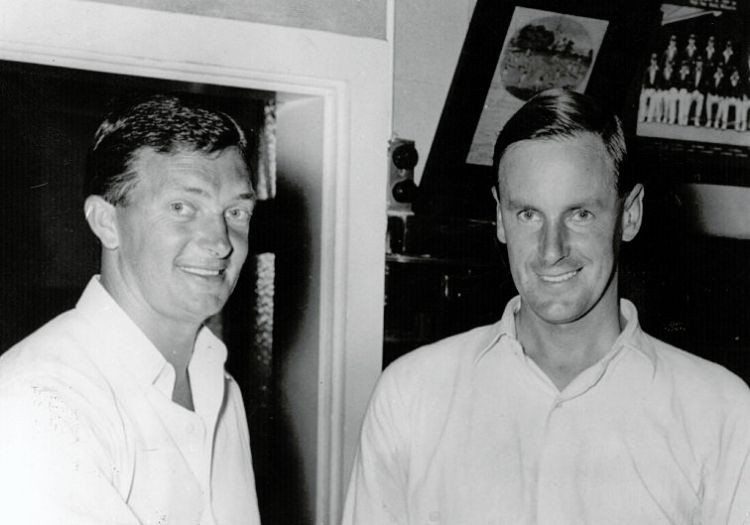
Richie Benaud and Peter May
Graveney said: "We expected it from Trevor. He was his usual, bloody-minded self. No one objected. A player knows his responsibilities if he has been in the game for a while."
There was controversy, though, when Cowdrey was given out 'caught' by Lindsay Kline, the Victoria off-spinner, off Meckiff for 28 – the second time he fell to that combination in the Test. The umpires, after consulting, said that the ball had carried – many onlookers felt it had bounced just in front of the fielder.
The incident unsettled the tourists, and perhaps inspired Bailey to even greater levels of stubbornness, although he finally succumbed to a rush of blood and was bowled by the gum-chewing occasional seamer Ken 'Slasher' Mackay. Benaud took 4 for 66 this time. He was to have a very good series.
Bailey’s innings must have made an impression on Australian opener Jimmy Burke, who somehow managed to score even more slowly than Bailey in the fourth innings of the match, grinding his way to 28 not out in 250 minutes. Norman O’Neill’s unbeaten 71, on debut, and with the handicap of a badly bruised thumb, was considerably more enterprising. His blistering drives helping Australia to an eight-wicket win. "Norman was a magnificent player, but he was desperately nervous early on," said Graveney. "If he hit the ball in the middle he ran... his opening partners tended to know what was coming!"
It was Cowdrey’s turn to frustrate Australia in the third Test at Sydney, as England denied the hosts victory for the only time in the series. For the third time in a row the tourists won the toss, and they scored 219. It was a disappointing performance, with Benaud taking five wicket.
O’Neill made 77 and Davidson 71 as Australia reached 357 in reply towards the end of day four of the six-day match (rain had written off much of day two). Laker took five wickets and Lock four.
Cowdrey then compiled an unbeaten century that took 362 minutes and 302 balls, making it the slowest century in Ashes Tests until Bob Woolmer took 394 minutes to reach three figures at The Oval in 1975. Australia had to do without Meckiff, who broke down with a bruised heel and pulled Achilles tendon. They were set 150 to win in 110 minutes, but ended on 54 for 2.
Australia clinched the series at Adelaide, winning by 10 wickets, their most emphatic victory of the series. Tyson was finally given his chance, but he struggled, taking 1 for 100, as Australia scored 476. May believed the gamble of electing to field was worth taking as England needed to win. The effort was not helped by the absence of Laker, who had injured a finger.
Colin McDonald was almost bowled first ball by Statham, but went on to score 170, despite pulling a thigh muscle and requiring a runner in the latter stages of his innings. He became the 50th Australian to score a Test century against England. He pulled a thigh muscle on 137, and although he managed to reach 149 without a runner, he used one for the last 21 runs of his innings.
Trueman, Tyson and Statham toiled away in 90-degree heat, but knew that the Ashes were slipping away, especially when the hosts’ score Australia closed day one on was 200 for 1 at the end of the first day. To make matters worse for England, Godfrey Evans re-fractured a finger and handed the keeping duties over to Graveney after the opening first day.
Cowdrey made 84 as England managed only 240 in reply, collapsing from 170 for 3, with Benaud taking 5 for 91. Following on, England fared a little better, making 270, Benaud taking 4 for 82. May (59) and Graveney (53 not out) did show some defiance, but Australia knocked off the 35 required without loss to regain the Ashes after a period of five years and 170 days.
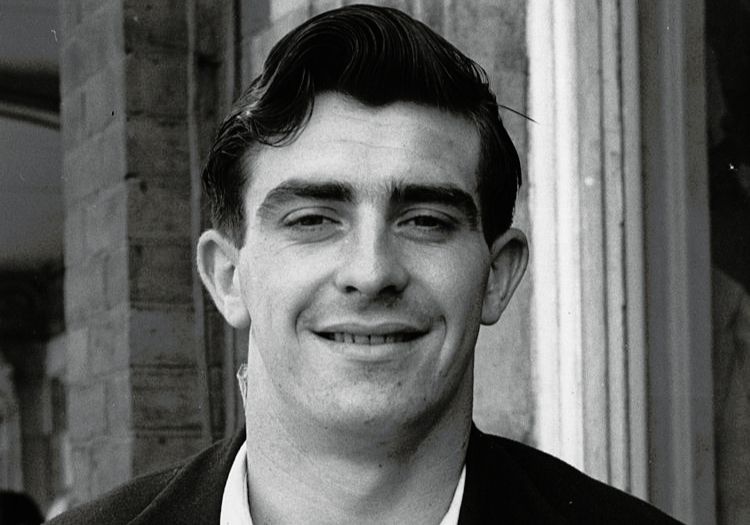
Fred Trueman
"The series was over by the time I was given a chance," said Tyson. "I’d been suffering from a long-standing heel injury, and I was back to my old run. My pace had cut down quite considerably. Alan Davidson said, my speed had dropped so much, he felt 'quite at ease against me', which I obviously didn’t want to hear!"
Australia refused to ease up in the fifth Test at Melbourne as they clinched a 4-0 win. England suffered a double blow before the match when they lost Loader and Statham, who were hurt in a car accident travelling from Wangaratta to Wagga Wagga.
The hosts finally won a toss and put the tourists in, and it turned out to be the first time this tactic had been successful since England captain Johnny Douglas had inserted the Australians in 1911/12. England were all out for a below-par 205. They were unfortunate when bowling, however, because when McDonald was on 12, a bail was dislodged as he glanced Trueman to the boundary. Roy Swetman, standing well back, appealed, but the umpire ruled in the batsman’s favour, and he went on to score 133 out of 351. Trueman took 4 for 92 and Laker 4 for 93.
Bailey again opened England’s innings, but was dismissed for a pair. Although Richardson made 68 (to put some shine on a poor series), England’s total of 205 was again poor, with Benaud taking 4 for 43.
Graveney made 54 in England’s second innings, but they managed only 214, with Lindwall dismissing Bailey, again opening, for 0 again. In this match Lindwall broke Clarence Grimmett’s Australian record of 216 Test wickets. Wicketkeeper Wally Grout, the popular Queenslander, also equalled Don Tallon’s record of 20 victims in an Ashes series. Australia then reached 69 for the loss of only wicket, in under an hour to secure victory.
Benaud took 31 wickets at 18.83 in the series. "He had been quite an ordinary bowler in 1953, although he was still a very dangerous allrounder, but he just got better and better," said Graveney. "He had won the captaincy ahead of Harvey before the series by the barest of margins, but he was very astute. McDonald was also an exceptional player, having a great series."
Australia were emerging as the dominant force in world cricket. They had won two series before England’s arrival in 1958/59, and would remain unbeaten in the next 11 series, until they lost in the West Indies in 1964/65. England, meanwhile, would have to wait until 1970/71 to regain the Ashes.